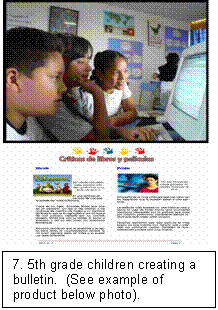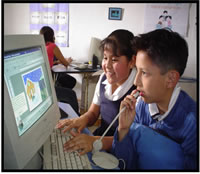MirandaNet presence in the UK and throughout the World
International | Africa | Bangladesh | Chile | China | CzechMiranda | Japan | Macedonia | Mexico | MiraNet | MirandaNorth | Poland | Regional | Romania | Star | Taiwan | Thailand | UK-Japan Science | UK-China Links | USA
 “Learning
Together”
“Learning
Together”
The Creation of Communities of Inquiry Supported by ICT
S.M. Rojas-Drummond*, C.D. Albarrán, M.G. Vega, M. Zúñiga & M. Vélez
Faculty of Psychology, National Autonomous University of Mexico
- Introduction
- General Description of the Programme
- Implementation of the Programme in each Grade
- Conclusions
- Bibliography
IV. Conclusions
 In
general, results of the multiple studies carried out throughout the 6 years
of implementation, have demonstrated that students who participate in the
programme “Learning Together”, in contrast with peers matched
on a wide variety of characteristics, develop significantly better social,
cognitive, psycholinguistic and technological abilities. These results in
turn have had a positive impact in the student’s school achievement.
In addition, the programme has demonstrated its’ potential to contribute
to diminish the high indices of functional and information illiteracy which
prevail among the Mexican student population.
In
general, results of the multiple studies carried out throughout the 6 years
of implementation, have demonstrated that students who participate in the
programme “Learning Together”, in contrast with peers matched
on a wide variety of characteristics, develop significantly better social,
cognitive, psycholinguistic and technological abilities. These results in
turn have had a positive impact in the student’s school achievement.
In addition, the programme has demonstrated its’ potential to contribute
to diminish the high indices of functional and information illiteracy which
prevail among the Mexican student population.
As part of our research, we have also analyzed in microgenetic follow-ups the quality of the interaction and discourse taking place as peers work together in different projects. We have also studied how these collaborative processes are appropriated by the students and evolve over time. Our results have lead us to confirm that the creation of communities of inquiry within schools supported by ICT, provides very adequate environments to induce the active participation and motivation of students. These communities in turn enhance learning, development, and the appropriation of diverse cultural tools. They also promote the co-construction of knowledge among all participants.
Our studies have also revealed that there can be important transference of some of the intervention strategies used in the programme to the classroom, enriching the way teachers conduct their educational practices.
In conclusion, “Learning Together” has demonstrated its’ potential for endowing primary students with relevant, flexible and functional repertoires which can enable them to participate more competently and independently as part of their community inside as well as outside of school.
E-mail:
[Back]

